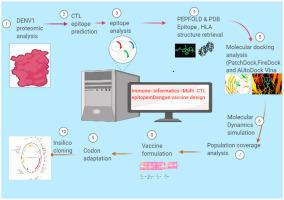Microbial Pathogenesis ( IF 3.8 ) Pub Date : 2021-01-02 , DOI: 10.1016/j.micpath.2020.104728 Sunil Krishnan G 1 , Amit Joshi 1 , Nahid Akhtar 1 , Vikas Kaushik 1

|
Dengue viral disease has been reported as an Aedes aegypti mosquito-borne human disease and causing a severe global public health concern. In this study, immunoinformatics methods was deployed for crafting CTL T-cell epitopes as dengue vaccine candidates. The NS1 protein sequence of dengue serotype 1 strain retrieved from the protein database and T-cell epitopes (n = 85) were predicted by the artificial neural network. The conserved epitopes (n = 10) were predicted and selected for intensive computational analysis. The machine learning technique and quantitative matrix-based toxicity analysis assured nontoxic peptide selection. Hidden Markov Model derived Structural Alphabet (SA) based algorithm predicted the 3D molecular structure and all-atom structure of peptide ligand validated by Ramachandran-plot. Three-tier molecular docking approaches were used to predictthe peptide - HLA docking complex. Molecular dynamics (MD) simulation study confirmed the docking complex was stable in the time frame of 100ns. Population coverage analysis predicted the interaction epitope interaction with a particular population of HLA. These results concluded that the computationally designed HTLWSNGVL and FTTNIWLKL epitope peptides could be used as putative agents for the multi CTL T cell epitope vaccine. The vaccine protein sequence expression and translation were analyzed in the prokaryotic vector adapted by codon usage. Such in silico formulated CTL T-cell-based prophylactic vaccines could encourage the commercial development of dengue vaccines.
中文翻译:

免疫信息学设计的非结构蛋白质组T细胞多表位登革热肽疫苗
登革热病毒病已被报道为埃及伊蚊蚊子传播的人类疾病并引起严重的全球公共卫生关注。在这项研究中,采用了免疫信息学方法来设计CTL T细胞表位作为登革热疫苗的候选药物。从蛋白质数据库中检索到的登革热血清型1株的NS1蛋白序列和T细胞表位(n = 85)通过人工神经网络预测。保守的抗原决定簇(n = 10)被预测并选择用于深入的计算分析。机器学习技术和基于定量矩阵的毒性分析确保了无毒肽的选择。隐马尔可夫模型派生的基于结构字母(SA)的算法预测了Ramachandran-plot验证的肽配体的3D分子结构和全原子结构。使用三层分子对接方法来预测肽-HLA对接复合物。分子动力学(MD)仿真研究证实,对接复合物在100ns的时间内是稳定的。人口覆盖率分析预测与特定HLA人口的相互作用表位相互作用。这些结果得出结论,通过计算设计的HTLWSNGVL和FTTNIWLKL表位肽可用作多CTL T细胞表位疫苗的推定剂。在通过密码子选择适应的原核载体中分析了疫苗蛋白质序列的表达和翻译。这样 这些结果得出结论,通过计算设计的HTLWSNGVL和FTTNIWLKL表位肽可用作多CTL T细胞表位疫苗的推定剂。在通过密码子选择适应的原核载体中分析了疫苗蛋白质序列的表达和翻译。这样 这些结果得出结论,通过计算设计的HTLWSNGVL和FTTNIWLKL表位肽可用作多CTL T细胞表位疫苗的推定剂。在通过密码子选择适应的原核载体中分析了疫苗蛋白质序列的表达和翻译。这样在计算机上配制的基于CTL T细胞的预防性疫苗可以鼓励登革热疫苗的商业开发。


























 京公网安备 11010802027423号
京公网安备 11010802027423号